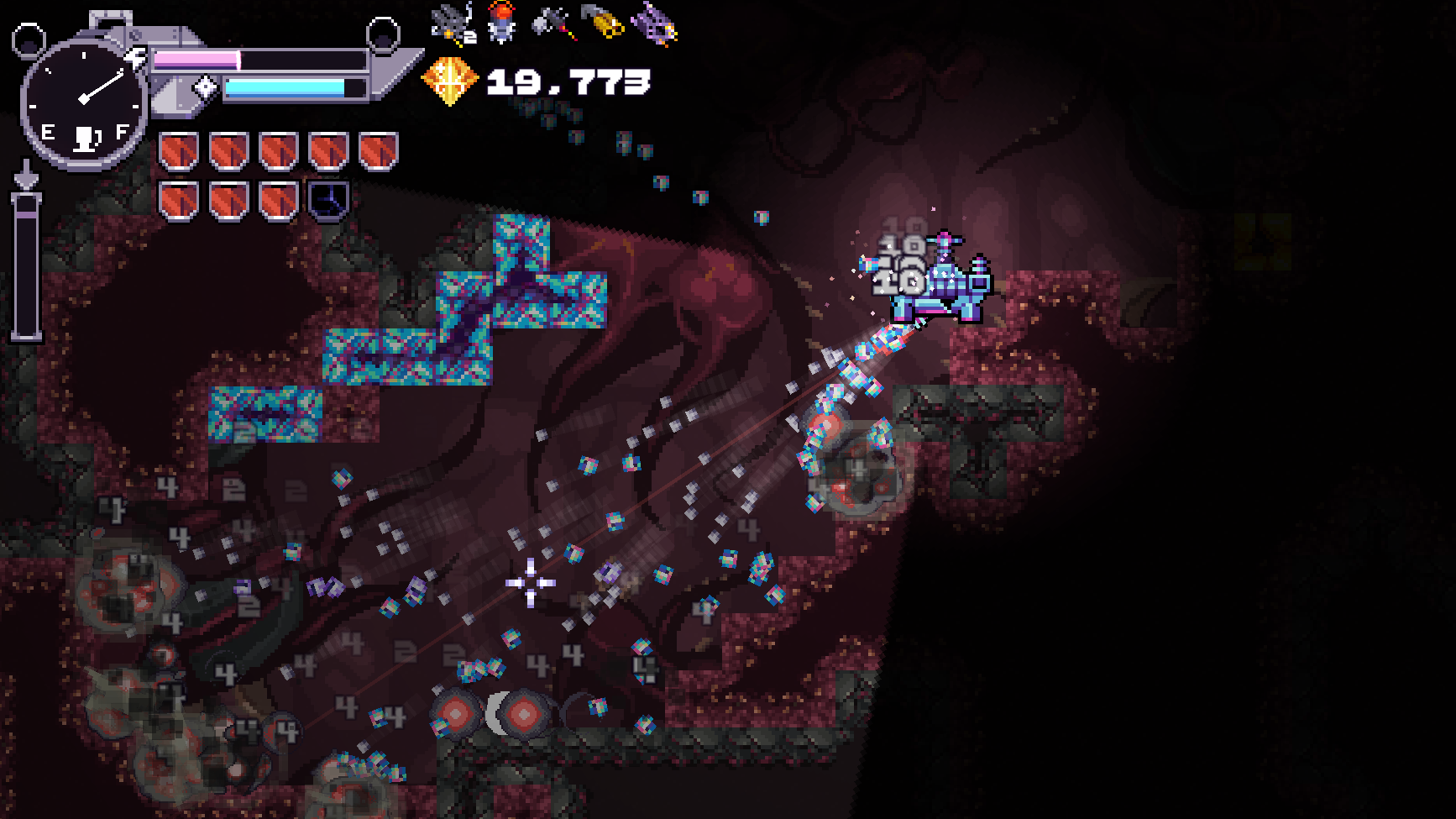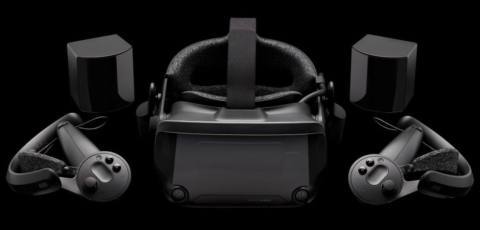What is it? A roguelike arcade shooter about dwarves mining for gold and diamonds with attack helicopters.
Release date March 8, 2024
Expect to pay $9/£8
Developer 8BitSkull
Publisher 8BitSkull
Reviewed on AMD Ryzen 7 5700G, 16 GB RAM
Steam Deck TBA
Link Official site
I find myself in an airship that hovers above a floating island in space. I plunge to the planet’s surface via rocket and emerge flying an attack helicopter. My only instructions: shoot rocks, mine gems, and delve as deep as I can. So begins the first level of Bore Blasters, whose straightforward yet satisfying game loop had me initially hooked. It's just a shame it doesn’t quite go the distance.
First and foremost, gunning through stone simply feels great in Bore Blasters. Little numbers pepper the screen as my bullets find purchase, and each exploded cube sends gems flying to the top of the screen, filling up an bar that unlocks temporary “bolt-on” upgrades, and racking up my gold count for spending on permanent bonuses back at base. The ultimate goal of each level is a giant treasure chest floating in the deepest depths—grabbing it rewards you with a shower of gold and a new toy to play with in future levels.
The overall premise of the game is delightfully peculiar, and its colorful pixel art style imbues the world with an easy charm. Dwarves and sci-fi is a winning combo, and being given an attack helicopter as your primary mining tool is a great, silly twist. It’s a really easy game to fall in love with when you first start out—but sadly, it hits peak fun less than halfway through its short campaign, and my affection faded when it started to feel like my upgraded dwarf was outpacing the game’s ability to challenge me.
That first floating island is just one of many that I travel to over the course of Bore Blaster’s campaign. Completing each island unlocks those surrounding it, until there’s an entire grid of them to dig through.
Different islands feature distinct biomes, each with a unique flair. Some feature hive blocks filled with bugs that come flying out to attack if disturbed; on fiery islands, some blocks shoot out fireballs; grassy blocks appear on forest islands, and regrow no matter how many times you destroy them; and there are much stranger things besides, such as eyeball-themed levels with wild-eyed blocks that restrict your vision if you blow up too many of them. Learning to adapt to these different environments adds a nice touch of tension to each run, and lends the game a lightly explorative feel.

But that urge to explore must always be weighed against your limited fuel resources. The fuel gauge slowly depletes as you delve, acting as a ticking time bomb each level—run out, and your helicopter unceremoniously drops to the ground and explodes. The more time spent roaming around, mining for treasure, and fighting enemies, the less time is left over to reach that treasure chest at the bottom of the map—and it's not always easy to tell exactly how deep you'll need to go to get there.
It's a simple element of time pressure, but it conveys neatly a sense of urgency to the fast-paced levels. That turns what could have been a very methodical experience into a fun and frantic race to the finish, where glittering gems are always ready to tempt you off-course.
Rocky roads

Once I felt I'd developed a good mining strategy, earned some big upgrades for my helicopter, and discovered useful synergies between the various bolt-ons I'd unlocked, I was looking forward to tackling elevated challenges in the mid and late game. Unfortunately, those never really materialised.
The game's campaign plays out through quests—extra objectives that can be layered on to a level, charging you with anything from battling goblins to gathering mushrooms, with some accompanying dialogue between the ship's crew of dwarves. Initially, these quests can be tricky to complete against the time limit of your fuel gauge, hinting at challenges ahead. But the more I played, the more it became clear that not only does the game get increasingly easier, failure isn't really a concern anyway. Crash out in a level and you still get to keep all the resources you gathered, and finishing a quest still counts even if you then failed to complete the level. After a while, that inevitably makes it feel more of a grind than an adventure.
Uneven writing only worsens the problem. I wasn’t necessarily expecting a super rich story from a game called “Bore Blasters”, but I found the narrative elements confusing at times and actively grating at others. Most of the plot involves performing fetch quests for different intel or technology, activities that often feel more like padding than meaningful steps forward for the story.

Some quests do unlock specific bolt-ons or new playable characters, but they're few and far between—most simply give you some extra cash and some dialogue between the characters. That makes it hard to stay invested when those characters are being more irritating than fun. One quest that stuck with me for all the wrong reasons involved repeating an earlier mushroom-gathering activity in order to help a dwarf lie in an argument with his wife. It's a sequence that not only felt random and pointless, but made me actively dislike the character.
A few of the campaign quests do stand out, even if they're few and far between. My personal favourite flipped the script on the constant descent down towards treasure by throwing in an ocean of acid that started rising up towards me. Suddenly I was forced to dig my way back up to the surface, rescuing stranded civilians as I went and making risky maneuvers around rock formations and outcroppings. It was a perfect surprise just when I was getting too comfortable—with a few more moments like that peppered through, the campaign might have felt a little less flat.

In theory the three playable characters should help mix things up—each has their own special ability you can activate every time it cools down, from Gunnar's power to simply bulldoze through rock to Ragnhild's homing rockets. But neither can compare to Jarl. He fires a ray that turns swathes of rock into brittle gem clusters, which are easily broken and quickly fill the upgrade meter—it easily clears any obstacle while showering you with additional bolt-ons.
It pretty quickly became clear in my playthrough that he might as well be the only dwarf, given how universally useful he is. It would've been nice to utilise different characters for specific obstacles or approaches, but instead it felt like my power simply peaked once I unlocked Jarl—though balance tweaks made since launch at least suggest the developer is aware that there's some work needed to make the other dwarves feel as rewarding.
Hitting the latter stages with him, where my upgrades combined with his ability to create ridiculously overpowered builds, it felt like I could shred through whatever even the toughest biomes had to throw at me. With a ridiculously buffed rate of fire and damage, an ungodly amount of bombs and axes flying everywhere, an army of drones punishing any enemy that dared approach me, it came close to Vampire Survivors levels of euphoria at its best. But the buzz was short-lived and ultimately left me feeling unchallenged. Yes, I was super powerful in those moments, but I didn’t need to be, and I no longer had to pay any attention to the game's more interesting strategic elements.
There is good fun to be had with Bore Blasters before you hit that point. It's great for playing in short bursts thanks to the short and sweet levels, and it's hard not to smile at its goofy premise and relentless pace. But the lack of challenge scaling combined with an uninspired storyline make it just a weekend fling, not a long-term obsession.






